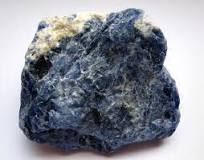
Sodalite: The Stone of Insight and Intellectual Harmony
Introduction
With its captivating deep blue hues streaked with veins of white or grey, Sodalite has long been a favourite among both crystal enthusiasts and collectors of natural mineral specimens. Revered for its calming energy and intellectual clarity, this crystal bridges the realms of intuition and reason. Whether admired in its raw, unpolished form or set into contemporary artisan jewellery, Sodalite offers a distinct blend of aesthetic depth and metaphysical value.
Geological Profile of Sodalite
Composition and Structure
Sodalite is a sodium aluminium silicate chloride mineral, classified within the feldspathoid group. Its chemical formula is Na₈(Al₆Si₆O₂₄)Cl₂, and it typically crystallises in a cubic system, though it is rarely seen in well-formed crystals. Most commonly, it appears as massive granular aggregates.
Its characteristic colour is a rich royal to navy blue, often laced with white calcite veining or specks of grey. This dramatic contrast makes Sodalite both visually striking and highly recognisable, especially in its natural, uncut form.
Natural Occurrence and Origins
Sodalite is primarily found in igneous rocks, particularly in nepheline syenites and other silica-poor formations. Notable sources include:
-
Canada (notably Bancroft, Ontario)
-
Brazil
-
Russia
-
Namibia
-
Greenland

Interestingly, the finest quality Sodalite—deeply saturated and evenly coloured—has often come from the Princess Sodalite Mine in Ontario, where the stone was first discovered in 1891.
Metaphysical Meaning and Healing Energy
Sodalite is often called the “Stone of Logic”, due to its association with the Throat (Vishuddha) and Third Eye (Ajna) chakras. It encourages rational thinking, clear communication, and deepened intuitive insight—a combination especially helpful for writers, teachers, healers, and meditators.
Energetic Qualities
-
Calm and Mental Order: Sodalite is said to help soothe the overactive mind, dispelling mental confusion and calming emotional turbulence. It’s ideal for those dealing with anxiety, panic, or chaotic thoughts.
-
Enhances Intuition: While it is not as overtly psychic as Lapis Lazuli or Amethyst, Sodalite stimulates deep understanding and insight, helping one trust their own inner wisdom.
-
Expression and Communication: By supporting truth and articulation, this stone is often used in practices that involve vocalisation, such as affirmations, public speaking, or relationship healing.
Its deep blue colour energetically resonates with a sense of depth and honesty, making it a powerful ally in both personal reflection and interpersonal dialogue.
Collecting Sodalite in Its Raw Form
Collectors prize Sodalite for its unique visual texture and bold coloration, particularly in raw and specimen-quality forms. Unlike polished versions that can appear overly glossy, raw Sodalite retains its natural matte surface and reveals intricate patterns of veining, inclusion, and mineral interplay.
Raw Sodalite specimens are ideal for:
-
Meditation spaces, where their presence brings mental clarity
-
Home altars, symbolising truth and discernment
-
Mineral specimen jewellery, where the natural stone speaks directly to Earth’s wild artistry
Sodalite’s affordability and widespread availability make it a gateway crystal for new collectors, while unique formations and well-matrixed pieces are increasingly sought after in the high-end mineral specimen market.
Sodalite vs. Similar Crystals
While often confused with Lapis Lazuli due to its similar blue colouring, Sodalite can be distinguished by its lack of pyrite flecks and its lighter, cooler tone. Where Lapis leans into regal depth and mysticism, Sodalite offers clarity and calm—more introspective than intuitive.
Dumortierite is another look-alike but tends toward purple or denim tones and often exhibits fibrous structures under magnification.
Sodalite’s energetic nature is gentler than many other blue stones. It doesn’t overwhelm; rather, it aligns, calms, and supports.
Jewellery and Creative Use: From Earth to Adornment
Raw Sodalite lends itself beautifully to mineral specimen jewellery, where its natural texture and vivid contrast offer a rugged elegance. In the hands of an artisan, a single chunk of unpolished Sodalite becomes a statement crystal specimen ring, a raw crystal pendant, or an earthy handmade gemstone necklace.
It pairs well with silver, oxidised copper, or darkened brass—metals that emphasise its cool tones and natural charm. Unlike overly refined gemstones, these designs preserve the primal narrative of the stone.
For wearers, Sodalite jewellery isn’t merely decorative. It acts as an energetic reminder to speak with truth, act with clarity, and hold space for one’s inner knowing.
Myth, Mystery, and Modern Reverence
Though not as historically famed as Sapphire or Turquoise, Sodalite has seen renewed appreciation in modern crystal communities, especially among those seeking grounding without dullness, clarity without detachment.
Some traditions consider it a stone of the philosopher, tied to the energy of the wise teacher and truth-seeker. There are accounts of ancient North American tribes using Sodalite-like stones in ceremonial contexts, though hard evidence remains limited.
Its recent popularity in spiritual practices stems not from ancient myth, but from its resonant calm in the modern mind.

A Note from Oryssia
At Oryssia, we honour stones like Sodalite for their untamed elegance and subtle energetic strength. Whether worn close to the throat or carried as a personal talisman, this crystal is not merely an accessory—it is a reminder to listen inward and speak outward with honesty.
We believe there’s something profound in wearing a piece of Earth’s memory. And Sodalite, with its moody hues and timeless calm, invites you to remember your own clarity within.